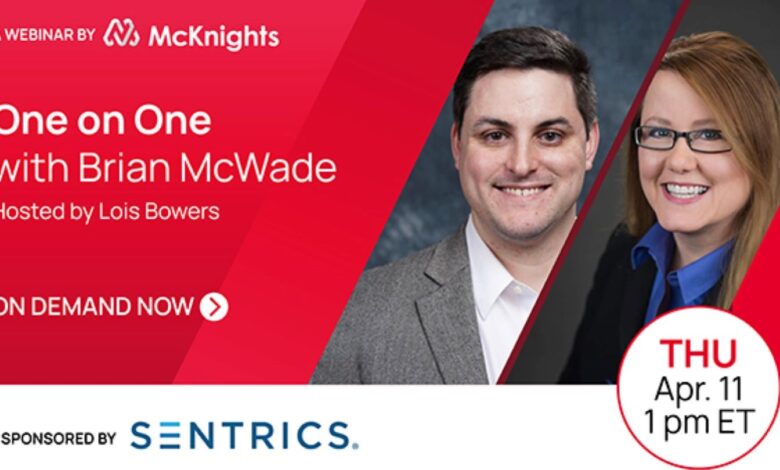McKnight’s Senior Living One on One with Brian McWade

How analytics can help improve workforce challenges, operations and efficiencies
Senior living communities continue to face significant staffing shortages, high turnover rates and operational challenges. The good news is that data analytics can help operators tackle many of those issues and provide more personalized service and care in an environment that is becoming more value-based.
That was the focus of a recent virtual discussion between McKnight’s Senior Living Editor Lois A. Bowers and Brian McWade, chief product officer of Sentrics. Portions of that interview are excerpted here.
Sentrics delivers technologic solutions to more than 7,500 senior living communities to boost resident entertainment and engagement, enhance staff productivity and ensure life safety. That scale of operations offers an uncommon opportunity to “look at the data and bring those data and those products together to drive some insights that are relatively new to the space,” McWade said.
Current staffing-related challenges
Staffing remains a challenge in every industry, and “senior living is an interesting environment, because you have to balance the delivery of care and the importance of social engagement with the resident,” he said. “You have an environment where people treat this as their home, and they’re there for a long period of time, and that brings a whole other level of challenge.”
For the senior living industry, the three core staffing-related issues are turnover, an aging workforce, and training and development, McWade said.
A high turnover rate can disrupt the continuity of service and care within a community, he said. “There is a decreased ability to provide person-centered care, attention and supervision, and there are missed opportunities for social interaction,” McWade added.
That staffing turnover affects not only the resident experience and length of stay but also perceptions among families, residents and prospective residents as well, he said. And in some states, increased regulation since COVID-19 has exacerbated staffing issues in senior living via new staffing ratio requirements, added responsibilities and compliance challenges.
The aging workforce further complicates senior living staffing, McWade said. Today, most residents use smart devices multiple times a day, yet many communities have not evolved to reflect this change, creating more inefficiencies and a disconnect with residents, he said. And compounding the issue is the lack of staff training on how to interpret existing data about the community and its residents.
Improving care with data analytics
But data analytics offers an opportunity for operators to address many workforce and operational challenges, McWade said.
Although general reporting summarizes data, “analytics is the systematic analysis of data to uncover insights patterns and trends,” he said. A community, for example, can explore data to find out why a resident uses a product the least or the most, and when.
To enhance outcomes, minimize risk and improve service, Sentrics uses descriptive, predictive and prescriptive analytics, McWade said.
“Descriptive analytics summarizes historical data to describe things that have happened in the past; predictive analytics takes the same historical data and applies algorithms to forecast future outcomes; and prescriptive analytics takes the data and recommends specific actions and strategies,” he explained. For example, if caregiver X is busy on Tuesdays and caregiver Y is not busy on Wednesdays, then those two caregivers together can help provide better-quality, faster service on certain days in the future.
Those processes, McWade said, can be applied to key operational components of operations, including resident care, staffing and workforce management, financial and operational analysis, and resident satisfaction. Data can be used, for example, to detect incremental resident changes and identify residents who need more care, to leverage employees better and free up personnel to work in understaffed areas.
Tackling the challenges communities face
Data analytics typically falls under the purview of those who handle information technology; however, IT tends to focus on the management, deployment and support of hardware infrastructure, which is different from analytics, McWade said. Most IT departments need further effort to be able to collect, process and analyze data as well as build recommended insights, he added.
Equipped with those capabilities, communities can improve staffing and operational efficiencies, McWade said. For example, “If floor two isn’t busy on Tuesdays and floor three is, then a community can take some resources from floor two and apply them to floor three on Tuesdays, to optimize the experience,” he said. Doing so, he added, also can help eliminate caregiver burnout and alleviate stress.
Data analysis also can help improve life safety and engagement, McWade said. “If you can identify proactively your high-touch residents, then you can start to determine other ways to interact with them,” he said. “There’s a lot of repetitive reactiveness in our industry, and the more we can get in front of it, the more we can help alleviate that.”
Engagement is a critical piece of the wellness and vibrancy of a community, yet activity directors spend more time planning than execution, McWade said. From pinpointing popular events and dates to automatically creating and pushing out information bulletins, “there are ways that we can use data to identify trends that can reduce that time spent planning so that it can be used much more efficiently,” he said.
Implementing analytic solutions
The first step that a senior living community can take to implement analytics solutions, McWade said, is to identify its goals, challenges and desired outcomes. It’s essential to assess the data availability and the quality of those data, he said.
“You’re going to have existing systems in place, and although they provide the actual service you need, you may not have looked at them from the quality of that data, the ability of that data to be outputted or integrated into other areas,” McWade said.
Training is equally important, he said. “If you’re not using [systems} appropriately or inputting the right information, then the quality of your analytics is not going to be where you need it to be,” he added.
Next, look at the company’s investment in technology and infrastructure, McWade advised. “The more pinpointed you want to get with data, the more infrastructure you need,” he said.
The future of analytics in senior living
Analytics will continue to shape staffing and overall management in senior living communities, McWade said.
“The future lives in that prescriptive analytics world,” he said. “That will give you some insight and analysis into what you should be doing in the future to run your business more effectively.” For example, he added, predictive analytics can provide recommendations on burnout and leveling out, and on how to use which staff members where and more.
As the industry moves toward more personalized service and value-based care, those insights will prove invaluable, McWade said.
“The more you get into value-based care, the more you get into the social determinants of health and how that impacts the overall care progression of a resident, and a lot of that is going to come from different analytics that you have through your products,” he explained.
For example, McWade said, Sentrics looks at time spent in room, socialization, peer groups, event attendance, television viewing, family visits and more. “These are all data points that can be brought together to help add value to your traditional electronic health record systems,” he added.
The key is “to start dipping your toe into analytics beyond general reporting,” McWade said. Ask existing vendors about their analytics strategy and future plans for including more descriptive and prescriptive analytics, he advised.
“Most importantly, make sure that when you go into these conversations, you have thought about your goal — your objective of what you’re trying to do,” McWade concluded.



